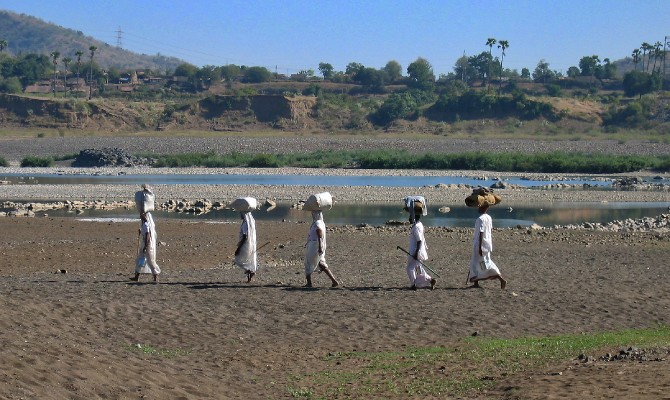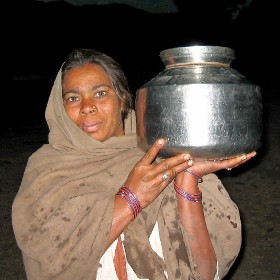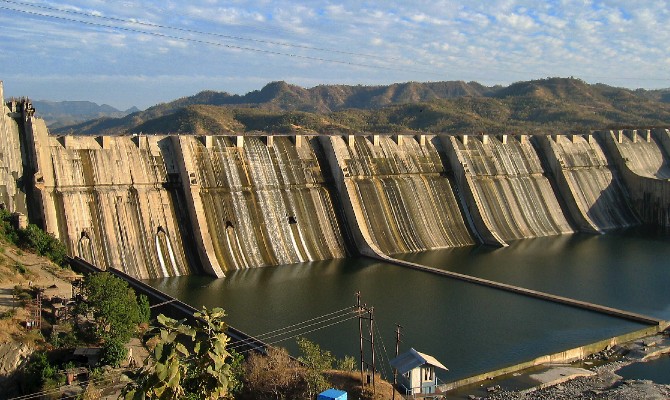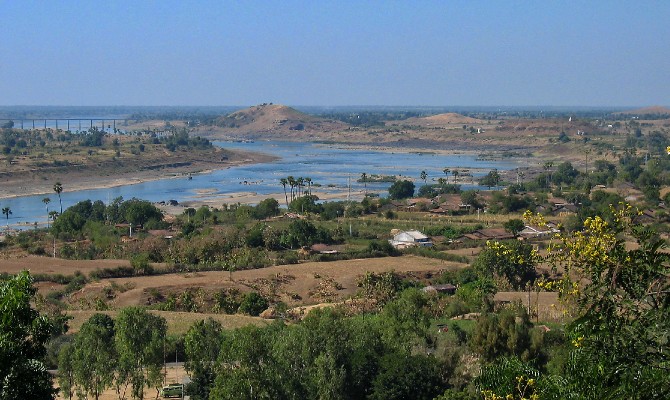NARMADA RIVER, India |
||
 |
||
Narmada pilgrims walking barefoot and carrying all their possessions. |
||
————————————————————————————————— This essay was originally posted to National Geographic's Water Currents blog on February 1, 2017. —————————————————————————————————
I was born from the sweat of the Hindu Lord Shiva while he was dancing. Or perhaps he was meditating so hard sweat flowed down his body to become my body. Or another legend says that I was formed from the tears of Lord Brahma. From whomever I was birthed, I am sacred, second in sanctity only to the River Ganges. I am like a mother, and am called Narmada Mai. My name, Narmada, literally means “the giver of joy.” Festivals, such as the Narmada Jayanti, honor me with thousands of oil lamps floated at night on my surface. I am also called Rewa, “the leaping one,” because as a strong-willed virgin, I move quickly to escape the advances of heavenly princes. The mere sight of my water is said to absolve a person from all their sins, whereas to gain the same grace, one must physically bathe in the Ganges.
Flowing east to west through a rift valley formed 400 million years ago, I am 815 miles (1,312 km) in length. Beginning at Amarkantak in the Maikala range of east-central India, my route carries me across the three different Indian States of Madhya Pradesh, Maharashtra, and Gujarat. At my humble source, waters from numerous springs collect to form rivulets that flow into a pond surrounded by white temples. My current produces oval, polished lingam shaped stones of cryptocrytalline quartz, called Banashivalingas, that are considered sacred, and are sought after for daily worship by Hindus. The unique markings on them are thought to be auspicious by those who worship Lord Shiva. |
||
 |
 |
|||
Fetching water from the river at dawn. |
Lingam stones. |
|||
Every year hundreds of sadhus (holy person or religious ascetic) and pilgrims begin the arduous Narmadaparikrama, a circumambulation of my entire body. Dressed in white and carrying their earthly possessions, devotees perform the meritorious act of walking from the Arabian Sea at Bharuch, along one side of me, all the way to my source at Amarkantak in Madhya Pradesh, and then return to the sea along my opposite bank, keeping my waters to their right. It is a two-to-three-year journey of over 1,600 miles (2600 km). At each small creek or tributary, the pilgrims scoop water into their cups, take a drink, and call out, “Bless Mother Narmada!” Every day prayers are offered to my flow, and small oil lamps are floated upon my spine. Along the route, pilgrims are given water, food, and places to rest. |
||
 |
||
Pilgrims stop to drink from a rivulet before continuing their journey. |
||
Both of my banks are lined with holy cities, temples, and bathing ghats (steps leading down to the water for easy access). Sugarcane, cotton, maize, lentils, millet, vegetables, and bananas grow beside me. In the few remaining forests of teak, mahua, and other trees along my shores, there are still tigers, leopards, bears, wolves, flying squirrels, hyenas, deer, monitor lizards, eagles, and hornbills.
Bathers must be careful of what is lurking in my water, because crocodiles have attacked and killed people. “Muggers” (Crocodylus palustris) have survived in my body for over two million years, and saltwater crocodiles (Crocodylus porosus) live in my estuary near Baruch. They feed on animal and fish carcasses thereby helping to keep me clean. The crocodile’s future is threatened by pollution, poachers, and the construction of dams, which hamper their movement and flood the shallow pools where they nest. I am sometimes portrayed as a lady dressed in a red sari, riding the back of a crocodile through turbulent waters. In these images, which are often carried by the pilgrims, I spread my arms wide to deliver blessings. |
||
 |
||
Sign warning of crocodiles near the Sardar Sarovar Dam site. |
||
Like the crocodile, the age-old pilgrimage along my banks has been threatened since the 1980’s by construction of a series of dams, both small and enormous. Extensive stretches of the path are currently submerged in the reservoirs of the Narmada Valley Development Project. The most colossal of these structures, the Sardar Sarovar Dam (SSD), is one of the largest in the world. Its reservoir has displaced over a million “adivasi” or original inhabitants of the region, mostly poor indigenous tribal people, whose entire culture and livelihood are at stake. Conflict continues between the Indian government and the courts as to whether these people affected by this dam are being adequately resettled and “rehabilitated.” Many villagers who have been displaced to resettlement sites have not received new land, water or other entitlements. |
||
 |
||
Sardar Sarovar Dam. |
||
As early as 1946, there were plans to dam my body (or should I say damn my body?), and in 1961, Prime Minister Jawaharial Nehru laid the first foundation stone. But the construction did not begin in earnest until 1988, the same year that the Narmada Bachao Andolan (NBA), or Save the Narmada Movement, unsuccessfully called for all work to be stopped. In September 1989, more than 50,000 people gathered in my valley to protest the destructive development, yet the building continued. Now, I am raped, my sacred waters forced through pipes and turbines, my natural flow halted behind megatons of concrete that plug my bowels and block my flow, so that I can no longer perform one of my primary jobs of transporting sediments and nutrients to the long-term detriment of farmlands and fisheries downstream. |
||
 |
||
View of Narmada River from the dorm room of a dam worker. |
||
The key players in this unfolding drama surrounding the dam are numerous. The NBA consists of local people who bring media attention to the plight of the adivasi along my shores. The World Bank originally backed the dam with a $450 million loan, but after an independent review panel expressed concern over the environmental and social impacts, the bank withdrew support. The Supreme Court is an opponent of the NBA, and has often disregarded environmental studies. The government of India supports the building of a huge system of dams along the entire length of my anatomy, including thirty large structures like the Sardar Sarovar, Indira Sagar, and Maheshwar dams. There are also plans for 135 medium dams, and thousands of smaller structures, dikes, irrigation projects and related water infrastructure to harness me and my tributaries. This enterprise is referred to as “National Development.” The government continually argues that the benefits of hydroelectric power, flood control, and irrigation substantially outweigh the costs in human and environmental disruption.
The height of the Sardar Sarovar Dam has been raised several times and in June of 2014, the Narmada Control Authority gave final clearance to extend the height to 455 feet (139 meters). As the structure grows taller, the backwaters of the reservoir increase, inundating yet more biodiversity-rich forests, and rendering homeless more and more families whose lands are submerged.
Alternatives to big dams have been developed across India. Anna Hazare and Rajendra Singh have transformed arid land with watershed-based irrigation systems and revegetation projects. Though such efforts have had active participation from residents, they are relatively small in scale, and a more extensive shift in thinking needs to occur in a country-wide approach to water use. Urban communities expect tap water to be there for easy consumption, and commercial-scale agribusinesses also wants “water on demand” to meet the needs of their business model. A transformation is needed to bring demand for water into line with its natural availability. How is it that I am worshipped, and simultaneously desecrated and degraded? How is it that I am sacred and profane at the same time? |
||
 |
||
Hindi words for water written in henna and photographed in a room at dam site. Translation starting at top of image: little finger, “Sagar” or sea; ring finger, “Nadhiya” or river; third or middle finger, “Dhara” or flow; index finger, “Jal,” pure or holy water. |
||
But I take heart. A visitor from New Mexico, a desert place far away in the United States, sits on a river rock near me and describes a novel she’s reading. “A River Sutra,” by Gita Mehta, is about me and the people who live along my shores. In the story, a river minstrel, with cymbals on every finger, sings songs of praise for my sacredness. “O Holy Narmada, we all take refuge in your embrace.” Wouldn’t it be wonderful if every river - all my relatives around the world - had a minstrel to offer songs of praise?! |
||
next page: French Broad River >
< previous page: Saskatchewan River Delta




































